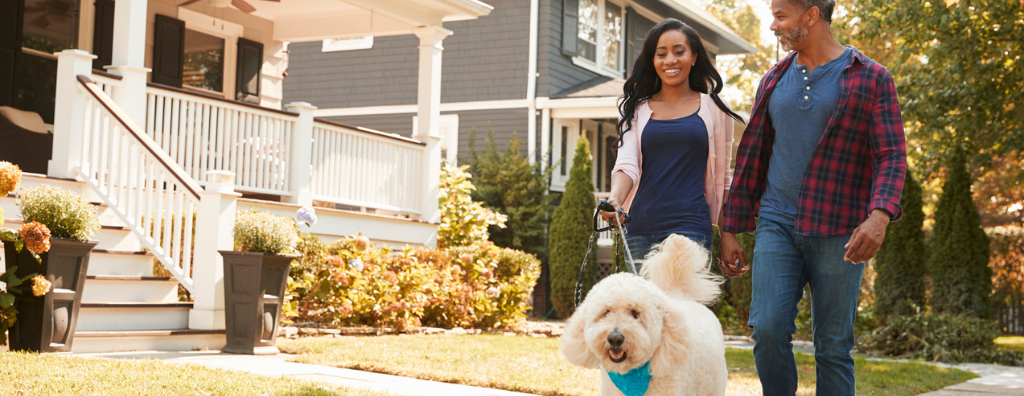For many of us, pets play a central role in our home life, so taking into account what is best for them when buying a home is important for both their happiness and that of your entire household.
Is the Neighborhood A Good Match For Your Pet?
When looking for homes that are well suited to both you and your furry companion, consider the area surrounding the home. If your pet is an indoor/outdoor animal, it’s important to examine the hustle and bustle of the neighborhood. If your pet spends time outside, a busy neighborhood could be dangerous, and depending on the level of traffic, he or she may need to be on a leash at all times.
How conducive is the neighborhood for taking your pet on walks? If you frequently walk your pet, look for neighborhoods with sidewalks. If your pet enjoys being off-leash, consider prioritizing homes with green belts, parks, trails, or designated off-leash areas nearby. It’s also a good idea to identify where the local emergency pet centers and veterinarian clinics are to insure there is sufficient medical care for your pet in proximity to where you live.
Does The House Meet the Needs of Your Pet?
- Size: Is the house big enough? Depending on the type of pet, or breed of animal, space may be the most important factor in picking a pet-friendly home. If you are moving into a bigger space than you were in previously, understand your pet will likely take to the additional room differently. On the flip side, if you are downsizing, be mindful of how it might impact your pet.
- Yard: If you have a pet that spends time outside, it’s important to pay particular attention to the yard. Is it large enough? Does it have a secure fence? Is there easy access between the home and the yard?
- Flooring: Pet-friendly flooring can be tough. Surfaces that can be repaired or refinished when scratched are typically the best options for homes with pets. Sealing additional layers will build up the resistance to damage from paws, claws, and general pet wear and tear.
- Carpet: Cats are notorious for clawing and scratching at carpet, and dogs are infamous for bringing the outdoors in with them. Consider carpeting of a lesser quality in the area where your pets spend most of the time, or search for carpets that are stain resistant and easy to clean.
- Stairs: Older pets and multileveled homes are at odds. Consider the age of your pet and how active you expect them to be so that you don’t find yourself in a position where you’re having to carry your pet between floors.
- Additions: If you’re comfortable with doing a little work on your potential home, you can consider adjustments that might make it a little more safe and comfortable for your pets. Adding an enclosed outdoor space for your cat called a catio or carving out space in the yard for a dog run can be just what your fur babies need.
More: 5 Pet Friendly House Cleaning Tips
What Does the HOA Say About Pets?
When looking at a home, ask whether or not it is a part of a Homeowners Association and what restrictions may apply to the property. For instance, certain HOA developments limit the number and/or type of pets per household.
Most pet owners take the needs of their pets seriously. In fact, in a recent Realtor.com survey, 95% of pet owners said that their pets needs were an important consideration when finding the right home to buy. When it comes down to it, prioritizing your pet when buying a home not only insures your pet’s well-being, but that of your household, as well.
 Facebook
Facebook
 X
X
 Pinterest
Pinterest
 Copy Link
Copy Link
